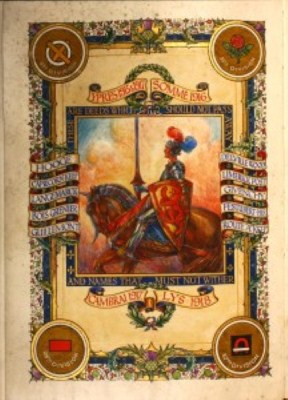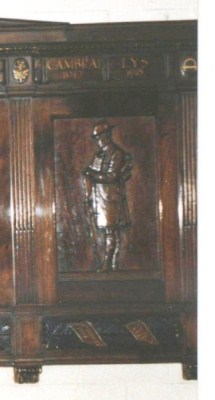WW1 Memorial St Andrews
The Wooden Liverpool Scottish Great War Memorial
(from St. Andrew's Church of Scotland, Rodney Street, Liverpool)
 This memorial is finely carved from what appears to be mahogany in the form of a triptych with two soldiers resting on their arms (rifles) reversed in the posture of mourning in the outer panels and an inscription in the centre panel. Similar figures appear on the bronze memorial which was at the Regimental HQ in Fraser Street and subsequently moved to Forbes House in 1967. It is likely, therefore, that the designer for this memorial was also H. Tyson Smith especially in the light of the stylistic similarities of the lettering adn the pediment. The inscription is given below. Immediately below the pediment are the divisional badges of those divisions with which The Liverpool Scottish was associated. These are also seen in the painted frontispiece of the Roll of Honour.
This memorial is finely carved from what appears to be mahogany in the form of a triptych with two soldiers resting on their arms (rifles) reversed in the posture of mourning in the outer panels and an inscription in the centre panel. Similar figures appear on the bronze memorial which was at the Regimental HQ in Fraser Street and subsequently moved to Forbes House in 1967. It is likely, therefore, that the designer for this memorial was also H. Tyson Smith especially in the light of the stylistic similarities of the lettering adn the pediment. The inscription is given below. Immediately below the pediment are the divisional badges of those divisions with which The Liverpool Scottish was associated. These are also seen in the painted frontispiece of the Roll of Honour.
 St Andrew's and The Liverpool Scottish. The memorial was offered to V (The Liverpool Scottish) Company in the 1970s when St. Andrew's closed its building in Rodney Street (now with the only shell facade of the church preserved). The Liverpool Scottish held their Remembrance Sunday Service at St. Andrew's until it closed, marching from Fraser Street with the Colours to the church even after the barracks there had closed. In subsequent years, a service was held at Forbes House and then the soldiers of V (The Liverpool Scottish) Company (including those who had taken part in the Liverpool Garrison service at St George's Hall) moved to Rodney Street with the Old Comrades, the Liverpool Scottish cadet units and the Liverpool Scottish Pipes and Drums to form up outside the church. From there, they marched down into Liverpool city centre, where the salute was taken in Lime Street in front of St. George's Hall, and then into St John's Gardens behind the Hall. In later years, a small ceremony has taken place in St John's Gardens at The King's Liverpool Regiment memorial and the Liverpool Scottish Stone of Remembrance following the Liverpool Scottish participation in the service at St George's Plateau.
St Andrew's and The Liverpool Scottish. The memorial was offered to V (The Liverpool Scottish) Company in the 1970s when St. Andrew's closed its building in Rodney Street (now with the only shell facade of the church preserved). The Liverpool Scottish held their Remembrance Sunday Service at St. Andrew's until it closed, marching from Fraser Street with the Colours to the church even after the barracks there had closed. In subsequent years, a service was held at Forbes House and then the soldiers of V (The Liverpool Scottish) Company (including those who had taken part in the Liverpool Garrison service at St George's Hall) moved to Rodney Street with the Old Comrades, the Liverpool Scottish cadet units and the Liverpool Scottish Pipes and Drums to form up outside the church. From there, they marched down into Liverpool city centre, where the salute was taken in Lime Street in front of St. George's Hall, and then into St John's Gardens behind the Hall. In later years, a small ceremony has taken place in St John's Gardens at The King's Liverpool Regiment memorial and the Liverpool Scottish Stone of Remembrance following the Liverpool Scottish participation in the service at St George's Plateau.
 A detail of the right hand panel is shown to the left
A detail of the right hand panel is shown to the left
The inscription is
"To the glory of God and in grateful memory of over eleven hundred of all ranks of The Liverpool Scottish who gave their lives for King and Country in the Great War 1914 - 1919"
and below
"Their names are inscribed in the Regimental Roll of Honour"
This text is now placed on the back of the St Andrew’s Liverpool Scottish War Memorial now at the Garrison Church of St. Alban at Fulwood Barracks in Preston
Liverpool Scottish Wooden War Memorial 1914-1919
10th (Scottish) Battalion, The King’s (Liverpool Regiment) TF
This wooden tablet formed part of the Liverpool Scottish memorial to those who died in the First World War (1914-1919). The four elements of the memorial were a bronze tablet, including an illuminated roll of honour, originally placed in the Liverpool Scottish HQ at Fraser Street, an endowed cot at the Myrtle Street Children’s Hospital, a donation to the Scottish National War Memorial in Edinburgh Castle and this tablet which was placed in St Andrew’s Church (Church of Scotland) in Rodney Street, Liverpool.1
The 1/10th Battalion served in France and Flanders from November 1914 until 1919. The 2/10th Battalion also served in France and Flanders from February 1917 until amalgamated with the 1/10th Battalion on 30 April 1918. The 3/10th Battalion remained in the United Kingdom, mainly at Blackpool and Oswestry.
The wooden tablet and the bronze memorial were made to a design by Major Duncan Campbell FRIBA of the Liverpool Scottish and the designs were both executed in the workshops of the well-known Liverpool sculptor, H. Tyson Smith, responsible for Liverpool’s cenotaph. Both memorials show Tyson Smith’s distinctive lettering and design in the figures of two kilted soldiers resting on their arms reversed in the military attitude of mourning
The wooden tablet was unveiled in St Andrew’s on 10 June 1923 by General Lord Horne GCB KCMG ADC following a similar ceremony for the bronze memorial at Fraser Street. Others present were the Rev. C.A. Peacock CBE, Assistant Chaplain General at Western Command, the Rev. James Hamilton MA, Honorary Chaplain of the Liverpool Scottish, and the Rev. J.S. Macdonald MA, Minister of Sefton Park Presbyterian Church. St Andrew’s also housed, immediately after its presentation, the King’s Colour awarded to 2/10th Battalion on St George’s Plateau on 12 March 1922 in the presence of the His Grace the Duke of Atholl KT PC GCVO CB DSO TD, Honorary Colonel of the Liverpool Scottish. This Colour was later transferred to the Scottish National War Memorial on 31 July 1936.
The wooden memorial shows the two figures of soldiers resting of arms reversed with the names of the main campaigns (by year) in which the battalions fought across the top and specific areas in which the battalions fought are on scrolls along the bottom edge. These are not official battle honours but areas judged to be of particular significance to the battalions (such as ‘Route A Keep’ near Givenchy). In addition to the 1908 pattern of the Liverpool Scottish bonnet badge, the memorial shows the insignia of the divisions with which the 1/10th and 2/10th served abroad. These are the 3rd Division, the 28th Division, the 55th (West Lancashire) Division and the 57th (Second West Lancashire) Division.
When St Andrew’s Church closed in the 1975, the memorial moved to Forbes House at Score Lane in Liverpool, the HQ of V (The Liverpool Scottish) Company, 1st Battalion, 51st Highland Volunteers. In 1999, it moved to the Liverpool Scottish Museum at Botanic Road in Liverpool where it was rededicated in 2002 in the presence of the Lord Mayor of Liverpool, Councillor Jack Spriggs with the service conducted by the Rev. John Williams MBE CF, padre to the Liverpool Scottish Regimental Association. The Museum closed in 2008 and the wooden memorial has been placed in the care of the Garrison Church of St Alban at Fulwood Barracks by the Regimental Trustees of the Liverpool Scottish.
ILR Liverpool Scottish Museum Trust 8th September 2012
1 Liverpool Echo 10 June 1923
Previous page: WW2 Memorial
Next page: WW2 Roll of Honour